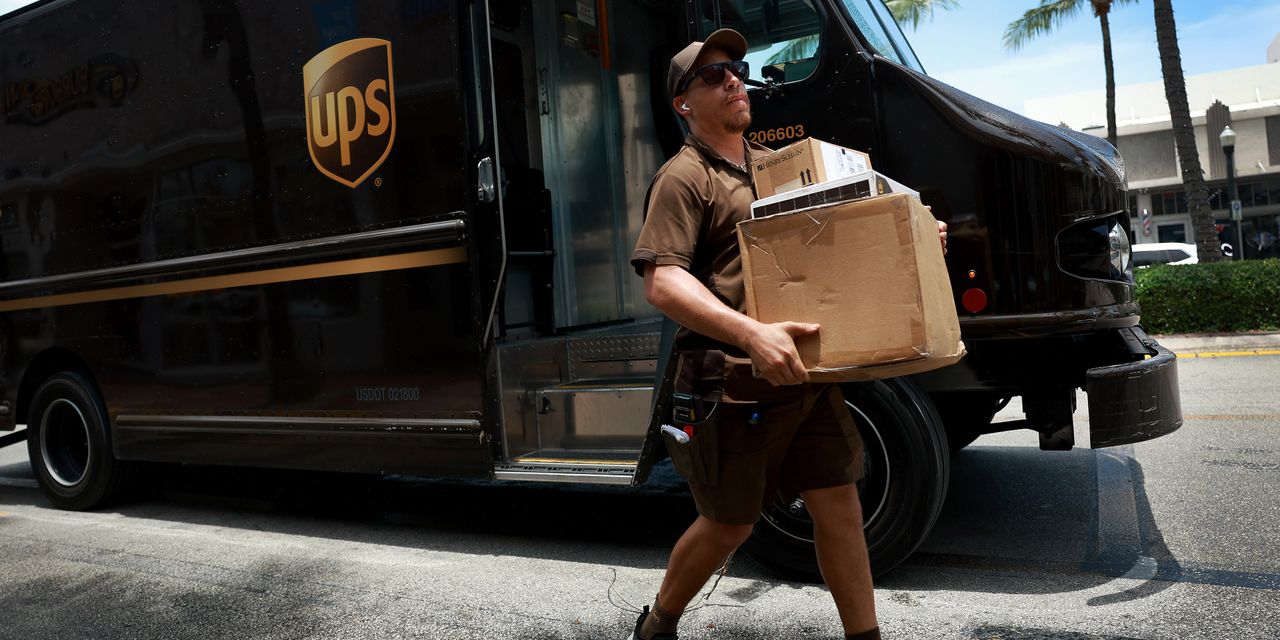The tentative labor deal announced Tuesday between United Parcel Service and the Teamsters union is a win for the company, its workers and the economy, but not necessarily the stock, analysts say.
Shares of UPS
UPS,
were down 1.4% on Tuesday. And while the deal would raise workers’ pay and temporarily removes the threat of a strike that risked miring the U.S. economy in further shipping delays and higher costs, one analyst said investors were still trying to parse the impact on the bottom line from more than three months of negotiations.
“This is a good thing for the economy,” Jason Miller, a professor of supply-chain management at Michigan State University, told MarketWatch. “It shows to me that the Teamsters were definitely in a strong bargaining position.”
He said that bargaining position reflected a broader trend in organized labor, where contract deals in the nation’s railroad industry and West Coast ports have arrived after what was a supply-chain crisis for most businesses two years ago translated into a profit windfall for shipping companies that were able to charge a premium amid the disruption. Workers have complained that their employers, ever under pressure from investors, have been reluctant to share those profits, skimping on time-off policies and seeking ways to slim down the labor force.
Concerns of a recession have hung over the economy, and labor laws generally favor employers in employee efforts to organize. But workers over the past two years have also been better able than normal to command higher pay from employers hoping to retain talent and had more room to entertain employment options elsewhere.
Miller also said that UPS stood to lose around 30% of its package volumes to competitors, like FedEx Corp.
FDX,
the U.S. Postal Service and regional deliverers, were a strike to occur. And he said a strike would have hit a variety of industries shipping high-value products — from electronics to clothing to spare auto parts. Health care, he said was the most serious.
“The health-care sector was the one that I think most of us were the most scared about,” he said. “UPS is a critical shipper for time-sensitive pharmaceuticals, reagents, biologics, et cetera. That would have been very difficult to divert those volumes.”
Talks between UPS and the Teamsters, which represents more than 340,000 UPS drivers and logistics workers, began in April. The deal still requires a broader vote from Teamster members. The voting process will run through much of August.
Some Wall Street analysts thought both sides would eventually get a deal done. But the negotiations were often tense, with some UPS Teamsters holding “practice pickets” amid the friction. And FedEx said those tensions “opened a lot of doors” for the company.
“We’re having a lot of great conversations with legacy UPS customers and we feel really good about the sales pipeline because of the strong value proposition we have versus our primary competitor,” Brie Carere, FedEx’s chief customer officer, said on the package deliverer’s earnings call last month.
Following the announcement of the deal between UPS and the Teamsters, Wall Street analysts on Tuesday said they were staying cautious until they could gauge the financial impact. Shareholders, they said, were likely to follow suit.
Evercore analyst Jonathan Chappell, in a note on Tuesday, cautioned that all of the information on the deal, so far, had come from the Teamsters, and that health-care and pension contributions weren’t addressed in the union’s press release announcing the agreement. He said he would be waiting to hear from both sides before he adjusted financial estimates on UPS. And while package costs could rise a bit more than expected, UPS could pull other levers to contain them.
“We are unsure what type of cost inflation was baked into the UPS 2023 guidance range, though given the above it does appear that the new contract terms would have exceeded internal expectations,” he said. “As a result, we would expect the 2023 guide to be reeled in a bit on August 8,” when UPS reports quarterly results.
He continued: “All told, it is great news for UPS (and the U.S. economy) that a strike was averted, but we remain on the sidelines until we receive final clarity on the impact from this long-awaited agreement.”
Stephens analyst Jack Atkins echoed that sentiment.
“While we believe the removal of a potential strike is a positive for UPS and its customers, until investors gain a clearer picture of the potential net dilution from this agreement and these negotiations have had on UPS’ market share, we look for the stock to remain range bound,” he said.
Shares of UPS are up 6.2% so far this year. By comparison, the S&P 500 Index
SPX,
is up 19.7% over that period.
Read the full article here




